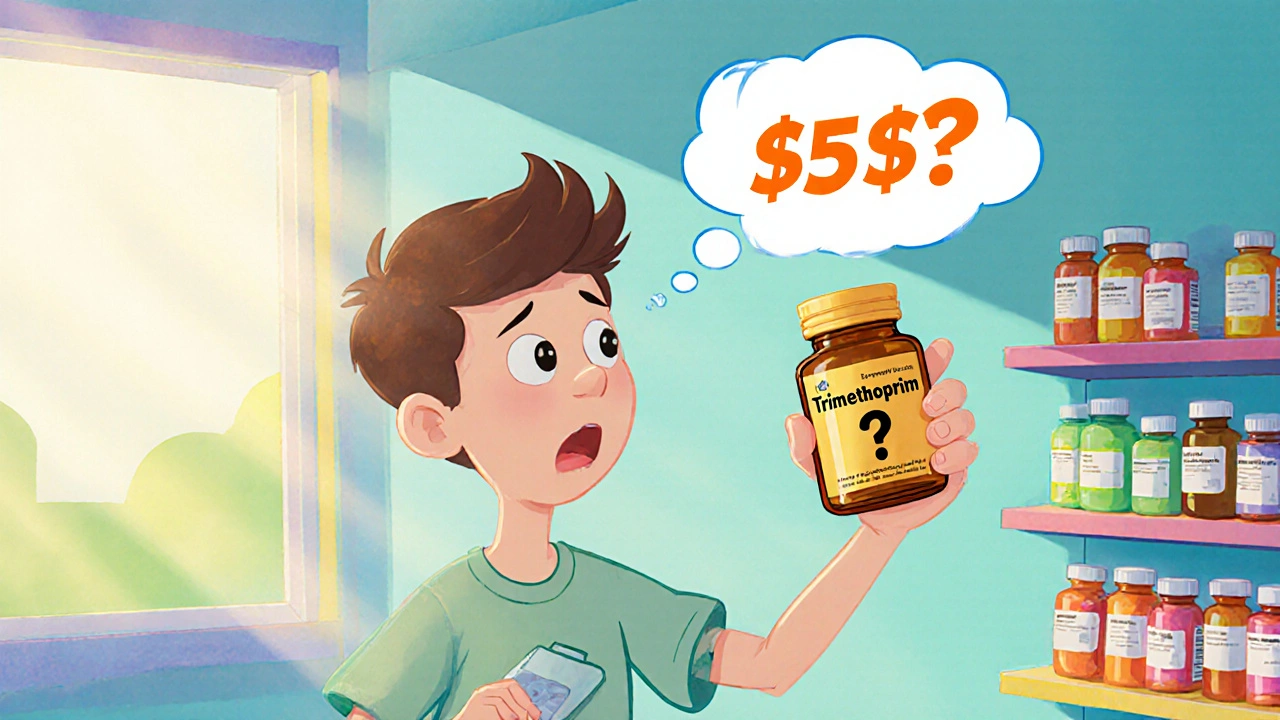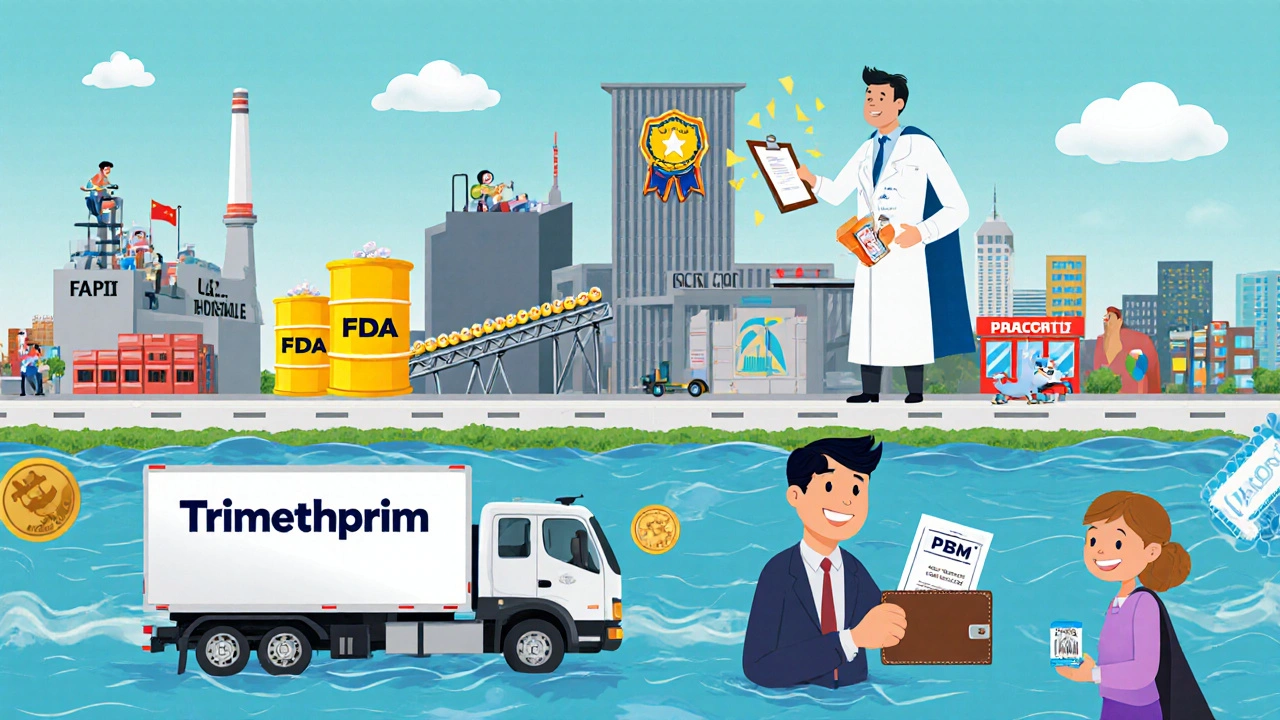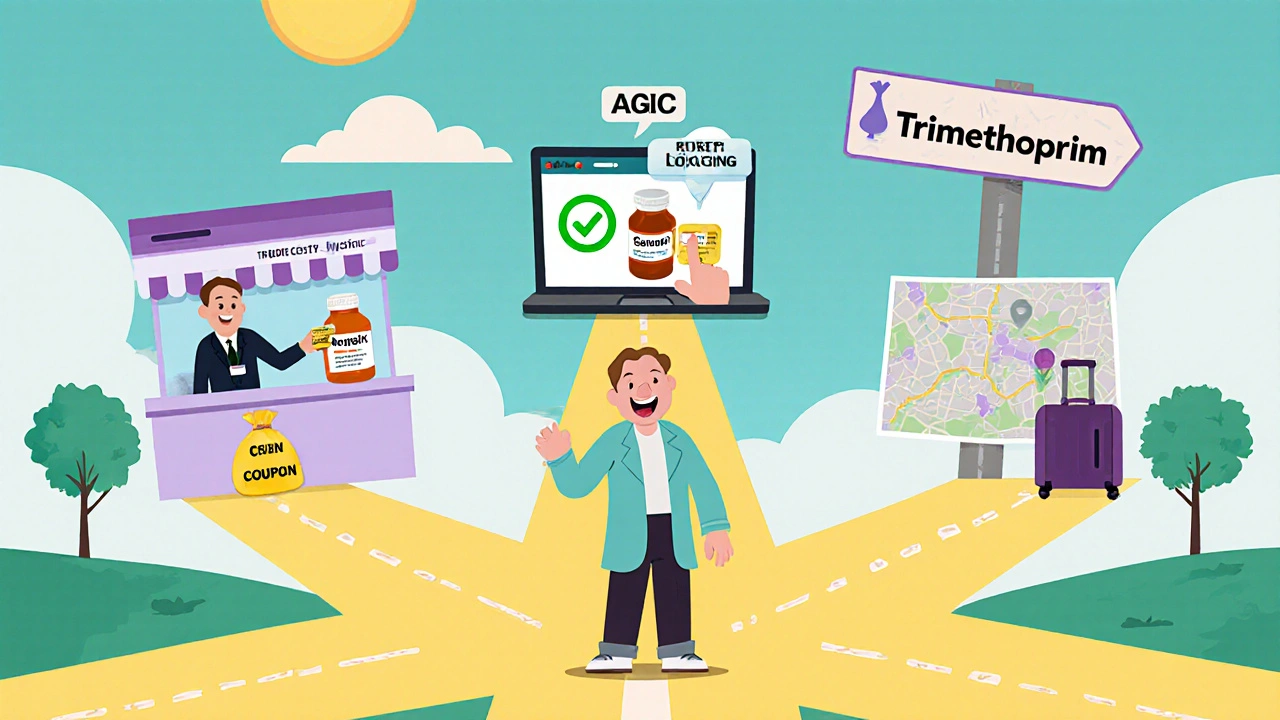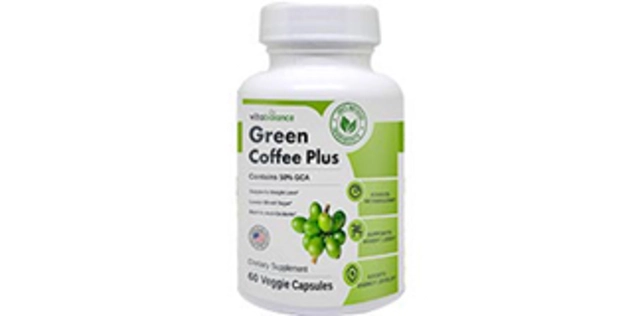Understanding Trimethoprim Price: Key Factors Behind Cost and Affordability

Key Takeaways
- Trimethoprim’s price varies widely due to manufacturing, regulation, insurance, and market competition.
- In the U.S., the average retail cost can be up to 8‑10 times higher than in Canada or Europe.
- Insurance design, Pharmacy Benefit Managers, and copay assistance programs heavily influence what patients actually pay.
- Supply‑chain disruptions and raw‑material shortages can cause sudden price spikes.
- Understanding the pricing chain helps consumers negotiate better deals and seek affordable alternatives.
When you pick up a prescription for Trimethoprim is a synthetic antibiotic used to treat urinary tract infections, traveler's diarrhea, and certain respiratory infections, you might be surprised by how much the out‑of‑pocket cost can differ from one pharmacy to the next. The trimethoprim price isn’t set by a single entity; it’s the result of a complex chain that includes raw‑material sourcing, manufacturing decisions, regulatory approvals, wholesale pricing, insurance formularies, and even geopolitical factors. This guide breaks down each link in the chain so you can see exactly why you pay what you do and what steps you can take to keep the cost manageable.
1. How Trimethoprim Gets Its Price Tag
Every medication follows a pricing pipeline that looks roughly like this:
- Raw‑material purchase (active pharmaceutical ingredient, or API)
- Manufacturing and formulation
- Regulatory approval (e.g., U.S. FDA or Health Canada)
- Wholesale acquisition cost (WAC) set by the manufacturer
- Distribution to pharmacies (often via drug wholesalers)
- Pricing by Pharmacy Benefit Managers (PBMs) and insurers
- Final retail price and patient copay
Each step adds a margin, a fee, or a cost that eventually lands on the consumer. For trimethoprim, because it’s an old, off‑patent drug, the manufacturing step is relatively cheap, but other layers-especially the U.S. insurance and PBM system-can inflate the final number dramatically.
2. Raw Materials and Manufacturing Costs
The active ingredient in trimethoprim is produced in large‑scale chemical plants, many of which are located in India or China. The cost of the API can swing between $5 and $20 per kilogram depending on purity, batch size, and regulatory compliance. A typical 100‑mg tablet contains only a fraction of a gram of API, so the direct material cost per tablet is roughly $0.001‑$0.002.
Manufacturing overhead-equipment depreciation, quality‑control testing, labor-adds another $0.01‑$0.03 per tablet. In countries with strong price‑control agencies (e.g., Canada’s PMPRB), manufacturers must report these costs, which helps keep retail prices low.
3. Regulatory Approvals and Their Impact
Before a generic version of trimethoprim can be sold, it must receive approval from the national drug regulator. In the United States, the Food and Drug Administration (FDA) requires bioequivalence studies, which cost $100,000‑$300,000 per formulation. While this seems huge, the cost is amortized across millions of tablets, so the per‑tablet impact is negligible.
However, the approval process creates a barrier to entry for smaller manufacturers, reducing the number of competitors and allowing the remaining players to keep prices higher than they would be in a truly open market.

4. Wholesale Acquisition Cost (WAC) and Average Wholesale Price (AWP)
Once approved, manufacturers publish a Wholesale Acquisition Cost. For trimethoprim 100 mg tablets, the 2024 WAC in the U.S. sits around $0.15 per tablet, while the Average Wholesale Price (a less transparent figure often used for pharmacy reimbursement) can be $0.30‑$0.45.
These figures are purely list prices. Pharmacies rarely pay the WAC; they negotiate discounts of 20‑40 % with wholesalers, but the discounts are not passed directly to patients because the PBM formulary tiers dictate the final copay.
5. The Role of Pharmacy Benefit Managers (PBMs) and Insurance Formularies
PBMs act as middlemen between insurers, drug manufacturers, and pharmacies. They negotiate rebates-often secret-to secure lower list prices. For trimethoprim, rebates are modest because the drug is already cheap, so PBMs rely more on tiered formularies.
Typical formulary tiers:
- Tier 1: Preferred generics - $0‑$5 copay
- Tier 2: Non‑preferred generics - $10‑$15 copay
- Tier 3: Brand‑name equivalents (e.g., Bactrim) - $30‑$50 copay
If your insurance places trimethoprim on Tier 2, you might pay $12‑$15 per 30‑day supply even though the pharmacy’s acquisition cost is under $2.
6. Geographic Price Differences
A quick look at three markets illustrates the spread:
| Country | Average Retail Price (USD) | Typical Copay (USD) |
|---|---|---|
| United States | $12‑$18 | $10‑$15 |
| Canada | $4‑$6 | $2‑$4 (often fully covered) |
| United Kingdom (NHS) | £2‑£3 | £0 (prescription charge waived for many) |
Canada’s price‑control board forces manufacturers to set a ceiling based on production cost plus a modest profit margin, which explains the lower retail price. The U.K.’s National Health Service negotiates directly with manufacturers, resulting in a similar low cost.

7. Supply‑Chain Shocks and Raw‑Material Shortages
In 2023‑2024, a dip in sulfur‑containing chemicals (used in API synthesis) caused a 35 % temporary price rise for many antibiotics, including trimethoprim. When supply tightens, wholesalers add a “scarcity surcharge,” and pharmacies may pass that on as a higher cash price for uninsured patients.
Monitoring real‑time market reports-e.g., from the International Federation of Pharmaceutical Manufacturers & Associations (IFPMA)-can give clinicians and patients a heads‑up before a spike hits.
8. Ways to Reduce Out‑of‑Pocket Costs
Knowing the price drivers lets you target the most effective levers:
- Ask for a generic substitution. Even if your doctor writes a brand name (Bactrim), most pharmacists can switch you to the cheaper generic.
- Shop around. Cash prices at big‑box pharmacies, online mail‑order services, and local independent drugstores can differ by $3‑$5 per prescription.
- Use manufacturer coupons or patient‑assistance programs. Though trimethoprim is generic, some manufacturers still offer discount cards.
- Check your insurance formulary. If trimethoprim is Tier 2, ask the plan to place it on Tier 1 or request a prior‑authorization for a lower‑cost alternative.
- Consider cross‑border purchasing. Canadians can legally import a 90‑day supply for personal use, often at a fraction of U.S. prices, provided the medication is from a licensed pharmacy.
9. Future Trends That Could Shift Prices
Two developments could change the landscape in the next few years:
- Policy reforms. U.S. proposals to cap insulin and generic drug copays may ripple to other antibiotics, forcing lower tier placement.
- Biotechnological manufacturing. Continuous flow chemistry promises to cut API costs by up to 40 %, which would eventually lower WAC and retail price.
Staying aware of these trends helps patients plan ahead and advocate for better pricing.
Frequently Asked Questions
Why is trimethoprim cheaper in Canada than in the United States?
Canada’s Patented Medicine Prices Review Board (PMPRB) caps prices based on production cost plus a modest profit margin. The U.S. lacks a nationwide cap, allowing insurers, PBMs, and pharmacies to add multiple layers of fees that raise the final price.
Can I get trimethoprim without a prescription?
In most jurisdictions, trimethoprim is prescription‑only because it treats bacterial infections that require a doctor's diagnosis. Some countries allow limited over‑the‑counter sales for travel‑related diarrhea, but it’s best to follow local regulations.
What’s the difference between trimethoprim and Bactrim?
Bactrim is a brand‑name combination of trimethoprim and sulfamethoxazole (SMX). The combination broadens the spectrum of activity. Pure trimethoprim is used when a narrower coverage is sufficient or when patients are allergic to sulfonamides.
How do insurance copays affect the price I actually pay?
Your insurance places each drug in a formulary tier. The tier determines the fixed copay you owe, regardless of the pharmacy’s acquisition cost. A Tier 2 placement can add $10‑$15 to your out‑of‑pocket expense even if the drug’s wholesale price is under $2.
Are there any programs to help pay for trimethoprim?
Some manufacturers offer discount cards, and many pharmacies have their own patient‑assistance programs that reduce the cash price. Additionally, using a health savings account (HSA) or flexible spending account (FSA) can offset the cost with pre‑tax dollars.
By peeling back each layer of the pricing chain, you can see that the headline number on your receipt is just the tip of an iceberg. Armed with this knowledge, you’re better equipped to ask the right questions, shop smart, and lower the cost of an essential antibiotic.






Buddy Bryan
October 25, 2025 AT 13:26Look, the whole PBM “rebate” circus is just a fancy way for insurers to jack up the trimethoprim copay while pretending they’re saving you money. They negotiate secret discounts with manufacturers, then shove the “savings” into higher tier formularies, so you end up paying $12‑$15 for a 30‑day supply that costs under $2 at wholesale. If you’re not locked into a high‑tier plan, demand a Tier‑1 placement or go straight to a cash price at a big‑box pharmacy – you’ll see the real cost in black and white.
Jonah O
October 26, 2025 AT 17:13Ever notice how every “price increase” in meds coincides with some shadowy board meeting in D.C.? The API suppliers in China are just a front for a global cartel that monkey‑writes the FDA’s bio‑equivalence studies. They say it’s “regulation” but really it’s a way to keep the true cost hidden and let the U.S. pay premium while other nations get cheap versions. Trust me, the numbers in the article are just the tip of a much darker iceberg.
Aaron Kuan
October 27, 2025 AT 21:00Trimethoprim’s price is a silent vampire, draining wallets.
Deborah Galloway
October 29, 2025 AT 00:46It’s frustrating to see patients struggle with a cheap drug that’s been marked up so heavily. Knowing how each step in the supply chain adds a little extra cost can empower you to shop around, use coupons, or even discuss tier changes with your insurer. You’re not alone in this, and a little extra legwork can really bring the out‑of‑pocket price down.
Charlie Stillwell
October 30, 2025 AT 04:33Wow, another generic‑drug price saga. The pharma “ecosystem” loves to throw buzzwords like “value‑based pricing” while basically shuffling cash between PBMs and insurers. 🤦♂️ If you’re looking for a real solution, stop trusting the “list price” and start demanding transparent discounts. The whole thing is a circus of hype and hidden fees.
Ken Dany Poquiz Bocanegra
October 31, 2025 AT 08:20Great rundown! The key takeaway is that you can actually bend the system: ask for generic substitution, compare cash prices, and use patient‑assistance cards. Small actions add up, and before long you’ll see the copay drop from double digits to single digits.
Tamara Schäfer
November 1, 2025 AT 12:06Honestly, the whole price chain feels like a maze with invisible walls. If the U.S. could just adopt the Canada‑style price caps, we’d see the drug cost shrink dramatically. Until then, keep an eye on formularies and don’t be afraid to push your insurer for a lower tier placement.
Tamara Tioran-Harrison
November 2, 2025 AT 15:53Dear colleague, whilst I appreciate your fervent enthusiasm for “buzzwords,” one must acknowledge that the so‑called “ecosystem” you champion is merely a veneer for systemic profiteering. Your reliance on emojis does little to mask the underlying economic absurdities. 😉 Nonetheless, let us strive for a discourse grounded in data rather than theatrical exclamations.
kevin burton
November 3, 2025 AT 19:40The supply‑chain disruptions mentioned, like the sulfur shortage, illustrate how even minor raw‑material issues can ripple through to the retail price. Monitoring these trends can help patients anticipate price spikes and plan accordingly.
Max Lilleyman
November 4, 2025 AT 23:26Nice sentiment, but let’s be real – most patients won’t bother checking formularies unless the copay is absurd. 🙄 The system is built to keep them in the dark.
Benjamin Sequeira benavente
November 6, 2025 AT 03:13Don’t let high copays crush your spirit! Take charge: shop online, use discount cards, and push your insurer for Tier‑1 status. You’ve got the power to slash that $12‑$15 bill down to pennies.
Terell Moore
November 7, 2025 AT 07:00One must first acknowledge the profound irony embedded within the modern pharmaceutical pricing paradigm, wherein a molecule synthesized in a modest laboratory in India can command a price tag rivaling that of a bespoke automobile. The narrative presented in the article, while thorough, scarcely scratches the surface of a labyrinthine financial architecture cultivated by a cadre of self‑interested intermediaries. Consider, for instance, the wholesale acquisition cost – a figure so obfuscated that it exists merely as a theoretical anchor for contractual negotiations between manufacturers and distributors. The subsequent layer, the average wholesale price, is a construct of such dubious provenance that it serves more as a rhetorical device than a reflection of tangible value. When insurers and pharmacy benefit managers intervene, they introduce rebates that are, by design, shrouded in secrecy, thereby ensuring that the end‑consumer remains blissfully ignorant of the true economics at play. This opacity is not accidental; it is a deliberate stratagem to perpetuate market dominance and suppress competition. Moreover, the tiered formulary system functions as a quasi‑taxation mechanism, extracting additional revenue from patients under the guise of “cost‑sharing.” The psychological impact of a $15 copay, juxtaposed against a $2 wholesale cost, cannot be understated; it engenders a perception of necessity that justifies the inflated expenditure. Let us not forget the geopolitical dimension, wherein trade policies and intellectual property regimes are wielded as tools to manipulate supply chains and, consequently, pricing. The fleeting supply‑chain shock described, involving sulfur‑containing precursors, epitomizes how contingent variables are exploited to justify temporary surcharges. From a macroeconomic perspective, these episodic spikes accumulate, exerting pressure on healthcare budgets and, ultimately, on taxpayer contributions. It is, therefore, incumbent upon the informed citizenry to demand transparency, to scrutinize the labyrinthine rebates, and to champion legislative reforms that cap out‑of‑pocket liabilities. Only through such vigilant advocacy can the entrenched status quo be challenged. Such reforms, if enacted, could recalibrate the balance of power toward patients rather than profit‑driven entities. In summation, while the article offers a commendable primer, the deeper currents of profit maximization, regulatory capture, and systemic opacity demand a more critical interrogation.
Lennox Anoff
November 8, 2025 AT 10:46The whole pricing charade feels like a staged performance, with each stakeholder playing a scripted role while the audience – us, the patients – watches the price tags rise like a plot twist no one asked for.